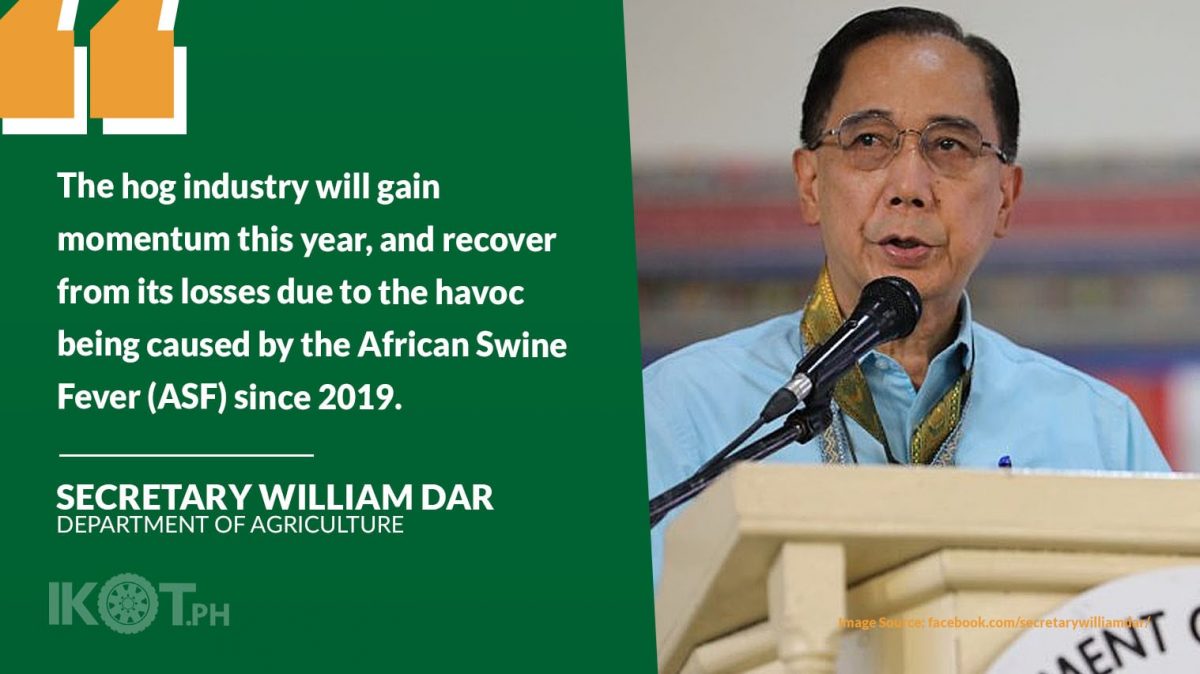Agriculture Secretary William Dar announced that there is enough pork supply, following efforts to strengthen and enhance local production and augment it through support from other countries.
The assurance was made, as the Department of Agriculture (DA) remains optimistic that the hog industry will gain momentum this year, and recover from its losses due to the havoc being caused by the African Swine Fever (ASF) since 2019.
To date, measures to prevent further damage from the transboundary animal disease are continuously being carried out from the national down to the local level, particularly in barangays and small communities.
As of January 13, 2022, active cases of ASF are reported in 45 barangays in 17 municipalities in Regions 2, 4A, 4B, 8, 11, and Caraga.
Based on the monitoring activities of the local government units (LGUs), validated by the DA- Regional Field Offices (RFOs), 553 cities and municipalities have been reported to be ASF-free for three months, 88 cities/municipalities with no reported cases for 3-6 months, and 435 cities/municipalities for six months. A total of 36 municipalities have also been released from quarantine.
This year, DA continues to implement twin programs Bantay ASF sa Barangay (BaBay ASF) program and Integrated National Swine Production Initiatives for Recovery and Expansion (INSPIRE) under the Bureau of Animal Industry (BAI) and the National Livestock Program (NLP) respectively, to bring the multi-million peso industry back on its feet.
“More areas, particularly in Benguet and Batangas, have upgraded their zoning status with the direction of the Babay ASF.”
According to BAI Director Reildrin Morales, more areas, particularly in Benguet and Batangas, have upgraded their zoning status with the direction of the “Babay ASF.”
“Babay ASF” extends technical assistance including disease monitoring, surveillance, and control. The initiative calls for stricter surveillance and monitoring efforts, which include setting up biosecurity measures for commercial and backyard piggeries.
“Once out of the red zone status, the areas can now start with the repopulation to increase and stabilize production.”
Morales added that once out of the red zone status, the areas can now start with the repopulation to increase and stabilize production.
As of this month, about 13,870 sentinel pigs have been distributed in areas that have zero cases.
Aside from being able to produce and sell hogs, areas that have moved out of the red zone are qualified to avail of credit assistance to help them revive their livelihood, and eventually, bounce back and recuperate from their losses.
With this development, a substantial increase in hog inventory was noted with a point seven million increase in population from January 2021 to January 2022.
The Philippine Statistics Authority noted an increase in hog inventory from 9.1 million to 9.8 million, in a span of one year.
Morales said that this is primarily due to the initiatives and efforts of the private sector, swine raisers’ groups, and professional veterinary associations, that continue to battle the threat of ASF with the government.
“These efforts, implemented in partnership with LGUs, have been instrumental in keeping the industry alive,” he said, stressing that the role of the local government, particularly at the barangay level, is very crucial in the success of the rehab and repop programs.
With the increase in hog population, pork supply has slowly stabilized, as production from local raisers across the country is augmented by frozen items sourced from other countries.
“These imported products are kept in cold storages and will be released to simply augment the supply gap. This is never meant to compete with the local producers,” Morales concluded.


